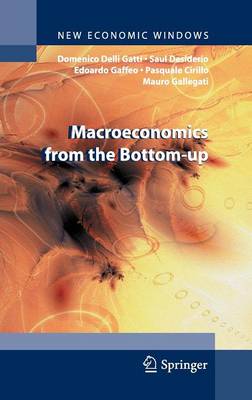New Economic Windows
4 total works
The Distribution of Income and Wealth
by Fabio Clementi and Mauro Gallegati
Emergent Macroeconomics
by Domenico Gatti, Edoardo Gaffeo, Mauro Gallegati, Gianfranco Giulioni, and Antonio Palestrini
Macroeconomics from the Bottom-up
by Domenico Delli Gatti, Saul Desiderio, Edoardo Gaffeo, Pasquale Cirillo, and Mauro Gallegati
We call our proposed approach Bottom-up Adaptive Macroeconomics (BAM). The reason why we claim that the contents of this book can be inscribed in the realm of macroeconomics is threefold:
i) We are looking for a framework that helps us to think coherently about the interrelationships among two or more markets. In what follows, in particular, three markets will be considered: the markets for goods, labor and loanable funds. In this respect, real time matters: what happens in one market depends on what has happened, on what is happening, or on what will happen in other markets. This implies that intertemporal coordination issues cannot be ignored.
ii) Eventually, it’s all about prices and quantities. However, we are mostly interested in aggregate prices and quantities, that is indexes built from the dispersed outcomes of the decentralized transactions of a large population of heterogeneous individuals. Each individual acts purposefully, but she knows anything about the levels of prices and quantities which clear markets in the aggregate.
iii) In the hope of being allowed to purport scientific claims, BAM relies on the assumption that individual purposefulbehaviours aggregates into regularities. Macro behaviour, however, can depart radically from what the individual units are trying to accomplish. It is in this sense that aggregate outcomes emerge from individual actions and interactions.
This book offers a thorough introduction to the highly promising complex agent-based approach to economics, in which agent-based models (ABMs) are used to represent economic systems as complex and evolving systems composed of heterogeneous agents of limited rationality who interact with each other, generating the system’s emergent properties in the process.
This approach represents a response to the limitations of the dominant theory in economics, which does not consider the possibility of a major crisis, and to the inability of dynamic stochastic general equilibrium theory to generate empirically falsifiable propositions. In the new perspective, the focus is on identifying the elements of instability rather than the triggering event. As the theory of complexity demonstrates, the interactions of heterogeneous agents produce non-linearity: this puts an end to the age of certainties.
With ABMs, the methodology is “from the bottom up”. The individualparameters and their distribution are estimated, and then evaluated to verify whether aggregate regularities emerge on the whole. In short, not only micro, but also meso and macro empirical validation are employed. Moreover, it shows that the mantra of growth should be supplanted by the concept of a growth.
Given its depth of coverage, the book will enable students at the undergraduate and Master’s level to gain a firm grasp of this important emerging approach.
“This book is flower blossomed by one of the two greatest Italian economists.”
Bruce Greenwald, Columbia University
“The author’s - the ABM prophet’s - thoughts on economics have been at the forefront of the world. Without a firm belief in and dedication to human society, it is impossible to write such a book. This is a work of high academic value, which can help readers quickly understand the history and current situation of complex economic theory. In particular,we can understand the basic viewpoints, academic status, advantages and shortcomings of various schools of economic theory.”
Jie Wu, Guangzhou Milestone Software Co., China



